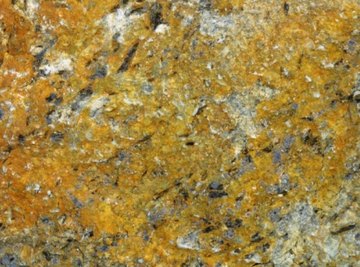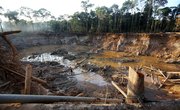
Gold deposits are found in different types of rocks and geologic formations, falling into two mining categories: lode (primary) and placer (secondary). Lode deposits are contained within surrounding rock whereas placer deposits are dust particles contained in streams and stream beds. Geographically, gold can be found on all seven continents, and the world's oceans also contain vast amounts of gold.
Lode Deposits
Lode deposits are the result of magna, high temperature and high pressure that thrust liquid gold up from Earth's crust. Cooling water seeping through the metamorphic rocks hardens the gold, resulting in ore deposits that run through sedimentary rocks as veins. Lode deposits are found in old rocks, older than 2.5 billion years, belonging to the Archanean geologic period and near sea floor volcanoes. Typically, granite, basalts and komatites are found along with lode deposits.
Placer Deposits
Placer deposits are concentrations of gold transported from enclosed rocks through erosion and gravity. Gold is resistant to weathering, but flakes and dust are easily transported via streams that surround gold-bearing geologic formations. Placer deposits accumulate in stream beds and in sand and gravel, also known as "black sands," and are heavier than other types of minerals. Other minerals found in black sands include magetite, cassitente, monazite, ilmenite, chromite, platnium metals and sometime gem stones.
Geography
Gold deposits are found in Northeast Canada, Brazil, Russia, the Congo, Egypt, Indonesia, Kazahstan and Australia. The world's oceans contain vast amounts of gold within sea floor sedimentary rock. The advantages of undersea mining include large deposits and unaffected landmass and populations. Furthermore, cyanide pollution will not be a factor because deposits are large enough to be recovered without acidic leaching; however, ocean floor mining techniques have not yet been developed to mine gold profitably from the seabed. The ocean floor around Papau New Guinea will likely be the first place gold mining exploration occurs once land deposits are fully exploited.
Political Geography
Politics play a role in mining available gold from across the globe. As of 2011, political stability in Canada, the United States and Australia are conducive to profitable gold mining. South Africa, on the other hand, provides a significant amount of gold, but political instability creates uncertainties regarding long-term supplies.
References
Resources
About the Author
Diane Bacher is a certified business energy professional with more than 16 years of experience in the environmental and energy sector. She has written numerous data and regulatory compliance reports for industrial, financial, educational and information-technology clients. Bacher's publications include the New Jersey Technology Council's "Tech News."
Photo Credits
Photos.com/Photos.com/Getty Images
